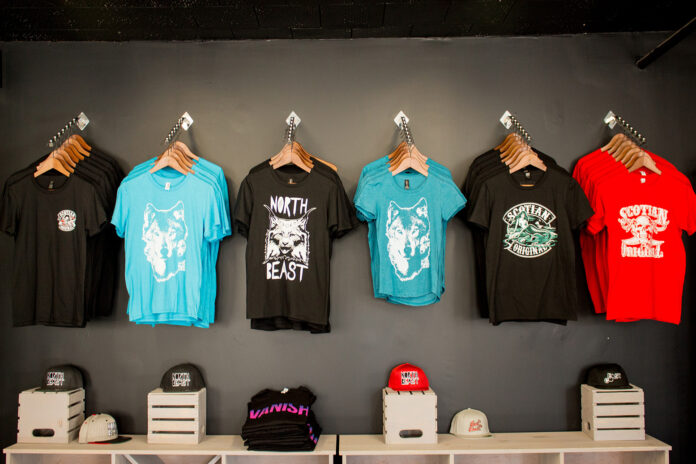Custom t-shirt printing is a versatile and creative way to express individuality, promote brands, celebrate events, or outfit teams. There are several methods available, each with its own advantages and specific applications. In this comprehensive guide, we’ll explore the main methods of custom t-shirt printing: screen printing, direct-to-garment (DTG) printing, heat transfer printing, and sublimation printing. We’ll delve into the process of each method, highlighting their unique characteristics and best-use scenarios.
Screen Printing
Overview: Screen printing, also known as silk screening, is one of the oldest and most popular methods of t-shirt printing. It involves transferring ink through a stencil (or screen) onto the fabric.
Process:
- Design Preparation: Create a digital design and separate it into different color components. There needs to be a dedicated screen for every hue.
- Screen Preparation: Coat a mesh screen with a light-sensitive emulsion. Once dried, place the screen under UV light with the design film on top. The light hardens the exposed emulsion, leaving the design areas soft. To see the pattern, rinse the screen. Rinse the screen to reveal the design.
- Setting Up the Screen: Secure the screen on a printing press. Align the t-shirt on the platen beneath the screen.
- Printing: Pour ink onto the screen and use a squeegee to press it through the mesh, transferring the design onto the t-shirt. Repeat this for each color, aligning the screens carefully.
- Curing: Dry the printed t-shirts using a conveyor dryer or heat press to set the ink and ensure durability.
Advantages:
- High durability and longevity of prints.
- Cost-effective for large batches.
- Vibrant colors and excellent opacity on dark fabrics.
Best For:
- Bulk orders.
- Simple designs with few colors.
- T-shirts needing high durability.
Direct-to-Garment (DTG) Printing
Overview: DTG printing involves using a specialized inkjet printer to apply ink directly onto the fabric. It’s similar to printing on paper but adapted for textiles.
Process:
- Design Preparation: Create or upload a high-resolution digital design.
- Pre-Treatment: Apply a pre-treatment solution to the t-shirt if it’s a dark fabric. This improves the ink’s adhesion and makes the colors pop more.
- Printing: Load the t-shirt onto the DTG printer platen. The printer head moves across the shirt, applying the ink directly onto the fabric according to the digital design.
- Curing: Use a heat press or conveyor dryer to cure the printed t-shirt, setting the ink and ensuring wash durability.
Advantages:
- High-quality, detailed prints.
- Suitable for small batches and one-off designs.
- No color limitations, making it ideal for complex, multi-color designs and photographic prints.
Best For:
- Small orders or single items.
- Designs with intricate details or many colors.
- Quick turnaround needs.
Heat Transfer Printing
Overview: Heat transfer printing involves transferring a design from a special transfer paper to the t-shirt using heat and pressure.
Process:
- Design Preparation: Create or select a digital design and print it onto heat transfer paper using a standard inkjet or laser printer. Alternatively, use a pre-made transfer paper with a design.
- Cutting (if necessary): If using heat transfer vinyl (HTV), cut out the design using a vinyl cutter. Weed away excess vinyl, leaving only the desired design.
- Positioning: Place the printed or cut design on the t-shirt in the desired position.
- Heat Press: Use a heat press machine to apply heat and pressure, transferring the design from the paper to the fabric. Follow the manufacturer’s instructions for temperature and time settings.
- Peeling: Remove the transfer paper backing carefully, ensuring the design adheres to the t-shirt.
Advantages:
- Suitable for full-color designs and photographs.
- Easy to use with relatively simple equipment.
- Ideal for small to medium-sized orders.
Best For:
- Small batches or custom orders.
- Designs with photographic or detailed imagery.
- On-demand printing.
Sublimation Printing
Overview: Sublimation printing is a method that uses heat to transfer dye onto fabrics, resulting in vibrant, permanent prints.Polyester or substrates coated with polyester provide the greatest results.
Process:
- Design Preparation: Create or select a digital design and print it onto sublimation paper using sublimation ink.
- Positioning: Place the printed sublimation paper face down on the t-shirt, ensuring proper alignment.
- Heat Press: Apply heat and pressure using a heat press. The heat causes the sublimation ink to turn into gas and bond with the polyester fibers of the fabric.
- Cooling and Peeling: Allow the t-shirt to cool briefly before peeling off the sublimation paper, revealing the transferred design.
Advantages:
- Permanent prints that won’t crack, peel, or fade.
- Vibrant colors with a smooth finish.
- Full-color, detailed designs are easily achievable.
Best For:
- Polyester fabrics.
- Designs requiring bright, permanent colors.
- Sportswear and activewear.
Conclusion
Custom t-shirt printing offers a range of methods to suit different needs, each with its own strengths and ideal applications.
- Screen Printing is best for bulk orders with simple, bold designs.
- DTG Printing excels in producing high-quality, detailed prints for small batches.
- Heat Transfer Printing is versatile for small to medium-sized orders and designs with intricate details.
- Sublimation Printing is perfect for polyester fabrics and produces vibrant, long-lasting prints.
By understanding the unique processes and advantages of each method, you can choose the best approach to create custom t-shirts that meet your specific needs and achieve the desired results. Whether for business, personal use, or special events, the right printing method can bring your designs to life with precision and style.

